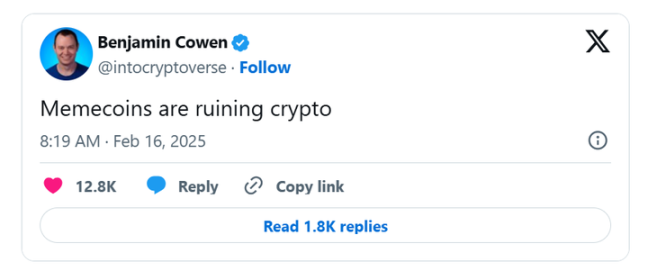As the host of Blockchain Banter, I recently led a discussion on memecoins - a topic that has sparked intense debate across the industry. Whether you love them or hate them, their impact cannot be denied. Some believe they are destroying the crypto industry, while others see them as a natural evolution of the decentralized market.
To delve deeper into this debate, I invited Justin Havens (Polygon DeFi Ecosystem Growth Lead) and Dr. Mark Richardson (Bancor & Carbon DeFi Project Lead) to join the discussion. We engaged in an in-depth conversation around the following core topics:
- The origins of memecoins and their role
- Regulatory challenges
- Investor vs. speculator mindset
- Influencers vs. Key Opinion Leaders (KOLs)
- The possibilities and limitations of DYOR (Do Your Own Research)
This dialogue revealed the multifaceted impact of memecoins in the crypto market. We welcome you to join the discussion!
1. The Memecoin Debate
Memecoins have sparked a significant divide in the crypto space. Some view them as an interesting and community-driven form of market participation, while others believe they undermine the industry's legitimacy. On one side, prominent figures like Benjamin Cowen have even stated: "Memecoins are destroying the crypto industry."

On the other hand, we've also seen industry heavyweights take the opposite stance, such as CZ, the co-founder and former CEO of BN (Binance), who posted photos of his pet dog Broccoli with an entire page of backstory, seemingly encouraging (or perhaps not 😏) the creation of more memecoins.
"I just posted a photo and name of my dog. I didn't issue a memecoin myself, whether to create one is up to the community (or not). However, I may interact with some of the more popular memecoins on the BNB Chain (BSC). The BNB Foundation may provide rewards for top memecoins on the BNB Chain, such as LP support or other incentives. The details are still being discussed, so stay tuned."

Justin believes that memecoins are not a coincidence, but rather the inevitable result of regulatory crackdowns on structured Token issuances. Due to concerns about legal risks, project teams have been forced to choose from the following options:
- Completely avoid any discussion of Token utility
- Opt for private fundraising, excluding retail investors
- Issue Tokens with no clear purpose
So, what happens when the only viable public Token issuance method is Tokens with no actual utility? The answer is the rise of memecoins.
Mark further points out: "Market incentives determine the ultimate outcome." Regulatory authorities have created an environment where Tokens with utility fall into legal gray areas, while Tokens that explicitly claim to have "no utility" ** face almost no compliance risks. The result is memecoins quickly dominating the landscape.
2. Investors or Speculators? The Delicate Line in the Crypto Market
One of the biggest misconceptions in the crypto space is the belief that there is a clear distinction between investing and gambling. But does this line truly exist?
Investors research fundamentals, assess risks, and make decisions with a long-term perspective.
Speculators chase hype, trade impulsively, and accept extreme risks.
Justin points out that many retail traders are forced into a "gambling mindset" because they are unable to participate in traditional early-stage investments. Unless you are an accredited investor, your only choice is speculative trading - which includes memecoins.
Mark believes that the line is much more blurred than most people imagine. After all, some of the best-performing crypto assets in history have been blatant scams. As he puts it:
"People will tell you not to invest in this, that it's a scam. And others will say, 'I know it is.'"
It is this paradox that fuels the frenzy around memecoins - the projects that appear most like scams sometimes end up delivering the biggest returns.
3. Have KOLs Fueled the Memecoin Frenzy?
The discussion naturally turned to KOLs (Key Opinion Leaders) and paid influencers - key drivers in the memecoin ecosystem. So, is the root of the problem the memecoins themselves, or the people who promote them for profit?
- In fact, there is a fundamental difference between true KOLs and paid influencers:
- True KOLs are respected industry builders and experts.
- Paid influencers often promote Tokens they've been hired to advertise, creating a false impression of organic market interest.
This also explains the other side of the memecoin hype - is it market demand that creates them, or is it artificially fueled?
4. Has the Term "KOL" Been Abused in Crypto?
Mark believes the term "KOL" is often misused in the crypto space. Many so-called "opinion leaders" are essentially just paid advertisers who are offloading Token allocations behind the scenes. If a project needs to pay people to talk about it, it's worth asking: Why does it need to do that?
The core question is about incentive structures. If someone is aggressively promoting a Token, ask yourself - what are they getting out of it?
5. DYOR: Is It Really Feasible?
The phrase "Do Your Own Research (DYOR)" is repeatedly emphasized in the crypto world, but the reality is often more complex than the slogan. As audience member Mike pointed out, DYOR is easier said than done.
Most people lack both the tools and the expertise to properly analyze:
- Token distribution
- Potential risks in smart contracts
- Liquidity structures and other key factors
While true on-chain analysis does require some investment, there are tools like Bubble Maps that can provide visual insights into Token distribution and potential scams. But ultimately, if you don't understand what you're buying, you're more like a gambler than an investor.
6. Can Memecoins Evolve? The Case of Sei
There was a counterargument in the discussion: some memecoins, though initially just a joke, have later developed into real projects.
Seiyan (a memecoin on the Sei chain) is a typical case - it started as a memecoin, but later launched its own aggregator, turning the community's momentum into a more tangible product.
The line between memecoins and utility Tokens is not always clear-cut. Sometimes, memecoins can grow into genuine projects that contribute to the ecosystem far beyond being a "fun Token".
7. Conclusion: Memecoins Are Here to Stay
Memecoins remain one of the most controversial topics in the crypto industry, and this discussion is far from over.
But one thing is certain - memecoins have become a part of the market, and they are not going away anytime soon. Their demand is market-driven, and until regulations are clear and can support structured Token issuances, memecoins may continue to dominate.
So, what is the root of the problem?
Is it the memecoins themselves?
Is it the speculative mindset of KOLs and the market?
Or is it the imperfect regulatory system?
As Justin summarized:
"If you fix the incentive structures, you can fix the market."







